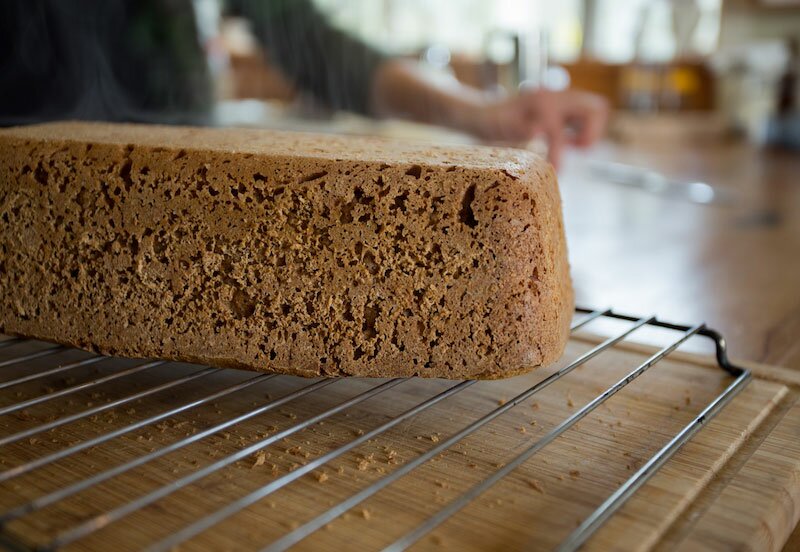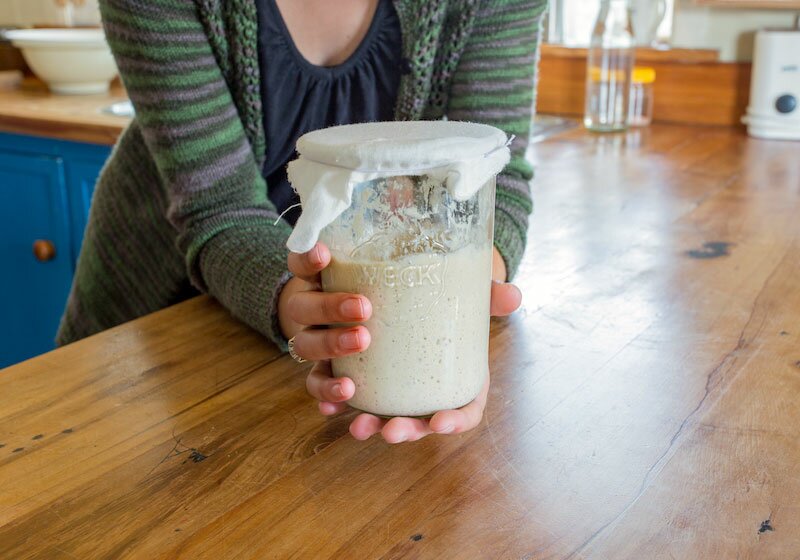Before I start writing this post about how much I love baking and eating sourdough bread, I just want to make it really clear that I am not an expert on sourdough, bread making, or baking! I’m just a really ordinary mum/homemaker who bakes enough bread to feed her family. I’m new to sourdough, and I’ve actually baked only one kind of sourdough bread because it was the first one we tried and we love it just as it is!
So now I’ve got that out of the way, I will proceed with my tale of how our appreciation for sourdough began. When my husband and I were still dating and we decided to move in together, we agreed we’d invest in a bread maker. My husband is a big man (6’7”) with a big appetite, and like most kiwi men he loves his bread. So we thought we were doing a really smart thing by investing in a good quality Panasonic bread maker that we calculated would pay for itself in about a year’s time. We were also interested in eating more ‘fresh’ food and avoiding processed food. Both of us had grown up believing that Molenberg bread was the definition of eating healthy, because it was full of seeds and it turned stale much more quickly than white bread (Oh, how I wished my mum would just buy us white bread for my lunches!). Now I was an adult at the beginning of an eco-friendly, health-seeking journey, and I had already noticed that supermarket-bought breads have lots of extra ingredients that don’t seem to be necessary for a homemade loaf. Ingredients like 471, 481, 263, and 330, canola oil, soy flour… and so on. So we baked our favourite coconut white bread loaf for a few years with our beloved Panasonic bread maker; we enjoyed every slice and we felt really good about ourselves because we were going the extra mile to eat healthy. I still have feel-good memories of getting a steaming hot fresh loaf out of the pan, slicing it thickly, and spreading the butter quick enough to have it melt off the knife and onto the bread. Yum.
Well, all that feel-good was killed about two years’ ago when I read a blog post about the dangers of Teflon. At this point in time, about half my kitchen was non-stick thanks to Teflon (and it wasn’t cheap stuff either!). We had no money to upgrade any of it to new, less scary alternatives. Eek! So I pounced on a big enamelled cast iron frying pan that my parents never used, and bought a couple of Dutch ovens second hand through Trademe. Out went the scratched up old non-stick pans, but what to do with our bread maker? Could we possibly live without it? We weren’t game enough to get rid of it, so we loaned it to my parents-in-law while we conducted our freaky new experiment: baking bread in the oven.
I made a Dutch oven bread with chopped dates for quite a while; it was tasty and Teflon-free. But it took half a day to organise and bake, and for a mum preparing for No.2, that routine was never going to endure. We ended up buying bread again, but this time from local sourdough bread makers, Volare. Volare bread isn’t cheap, but boy is it tasty! Neither my husband nor I were aware that we had any intolerance to gluten, but we were interested in the buzz about sourdough bread being tolerated much better by people who do. I had no intention of trying to bake it myself because the word “sourdough” intimidated me with imaginings of overwhelming complexity, a huge investment of time, epic failures, and flour everywhere.
Then one day, my good friend Holly (and photographer of my blog) came over for a photo shoot and dinner, and she brought with her a loaf of her own freshly-baked sourdough. She emphasised how easy it was to make and maintain, and I was intrigued. Holly gave me a little jar of sourdough starter with a few instructions, and left me to try it myself.
It was sort of like having a newborn baby handed over to me. Um, okay, so what do I do now? When do I feed it exactly? How often? How much? Can’t someone live with me for a bit and show me how to do it so I do it just right? But honestly, just as it is when you are caring for a newborn baby, you build a relationship with it, pay attention to it, and you get a feel for how to look after it right, so it can mature and grow 😉 .
So anyway, I killed Holly’s starter by dumping a whole lot of rye flour on it because I wanted to make it healthier and I didn’t follow her instructions.
But I was too embarrassed to tell her that, so I decided to have a go at growing my own starter from scratch using the comprehensive instructions and advice from kiwi blogger extraordinaire, Homegrown Kitchen. After seven disappointing days of barely noticeable activity in my flour-water mix, I was about to give up when I found the most incredibly reassuring and uncomplicating blog post at OurHeritageOfHealth. I decided to relax with the measurements of flour and water, and just feel my way through feedings by paying attention to the consistency of the starter, rather than measurements. I switched to a routine of feeding 1/2 cup organic white flour and enough water (approximately 2/3 of a half-measuring-cup) to make a thick batter, every 24 hours. I stirred vigorously for a minute or so to get the air in, measured out a good dollop of patience, and VOILA! it sprang to life and began behaving like it was supposed to do. Within a few hours of being fed, my sourdough starter would get full of bubbles and eventually double in size, before sinking again in a call to be fed.
I was now ready to bake my first loaf of bread! But I was still intimidated by what seemed to be an incredibly time-consuming, comprehensive process of dough-making. So I googled around for a really simple sourdough recipe, preferably requiring NO kneading at all, and guess what? I found one! It’s so easy and reliable that I haven’t tried any other recipes since. Everyone who’s tried my bread has loved it and can’t imagine it’s so easy to make.

No, I’m not going to show you how it’s done today; you’ll have to wait till next week’s post for that! But I figure that will give you just enough time to make your own sourdough starter from scratch, haha. “But why would I bother,” you ask? Well, now I will explain why you should go to all the trouble of making sourdough yourself:
1. Sourdough starter is simply a mixture of flour and (filtered) water. Prepared correctly, the sourdough starter comes to life when yeasts and bacteria in the flour establish themselves and begin to grow. When we were baking with our bread maker, we needed to use Surebake Instant Active Yeast to ensure it would rise nicely. Instant yeast is what most commercial bread makers use in their breads because it is controlled, consistent, and quick. However, have you ever noticed what’s actually in Surebake yeast? Edmonds Surebake contains: yeast, wheat flour, emulsifiers (472e, 481), flour treatment agent (300), sugar, vegetable oil, enzymes. So does that mean our home baked bread maker bread was – technically – still processed food?
2. Sourdough is easier to digest and more nutritious for it. The wild yeast and lactobacillus in the sourdough pre-digest the flour for us, releasing micronutrients and breaking down the wheat grain’s protective phytic acid, which is what gives some of us grief when we eat bread. Basically, it is so much nicer on your tummy and guts.
3. Sourdough is a fermented food, meaning it is rich in probiotics! Unfortunately the probiotics in your sourdough loaf will be killed by the heat when baking, but that doesn’t mean they aren’t still beneficial to your gut; in fact, it would seem that dead probiotics may still help our bodies fight inflammation.
3. Baking our own sourdough bread means it is now affordable for us to eat organic bread! Our loaves contain: organic wholemeal spelt flour, organic white flour, sea/rock salt, and organic molasses. Plus water.
4. It takes about 10 minutes to prepare the bread dough and feed the sourdough starter. It takes 45 minutes to bake it. Completely manageable in terms of time and effort.
5. The only plastic involved in the whole process is the container that the organic molasses comes in. We can buy the flours and salt from Bin Inn using paper bags or glass jars (BYO). I use a glass loaf dish for baking.
6. Fresh bread is delicious.
Finally, what have you got to lose by trying it? A bit of flour and water to grow your own starter. And a bit of flour, salt, molasses, and water to bake your first loaf.
In my next post I’ll show you how I prepare and bake my sourdough bread. Stay tuned!
Want to have a go at making your own sourdough starter? Check out the sourdough starter kit I’ve put together for sale in the Mrs Goodness Shop 😉 !
And, for your interest:
Wellness Mama’s article about why we should ditch Teflon
